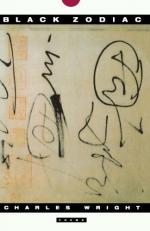|
This section contains 1,300 words (approx. 5 pages at 300 words per page) |

|
SOURCE: "Poetry in Review," in Yale Review, Vol. 85, No, 4, October 1997, pp. 166-75.
[In the following excerpt, Spiegelman examines visual observation in Wright's poetry.]
What James Joyce called the "ineluctable modality of the visible" continues to haunt and challenge our best poets. It may be their most ambiguous legacy from Romanticism. William Wordsworth's Boy of Winander, the unlettered poet who "blew mimic hootings to the silent owls / That they might answer him," stood amid a Lake District tableau that buried itself in his consciousness before he himself was buried within it: "the visible scene / Would enter unawares into his mind." Few of our poets are unaware of what they see. They try instead to claim it, subdue it, or, at the very least, reveal or describe it.
To the questions "What does description do?" and "What does a poet do with description?" Charles Wright and Jorie Graham offer radically...
|
This section contains 1,300 words (approx. 5 pages at 300 words per page) |

|


